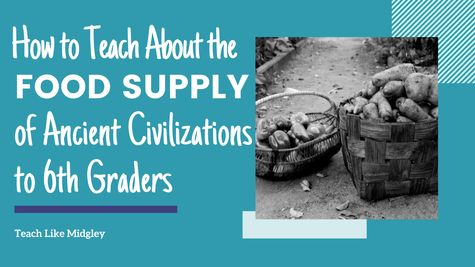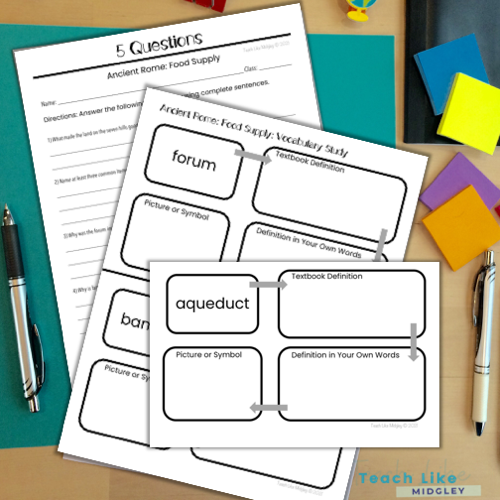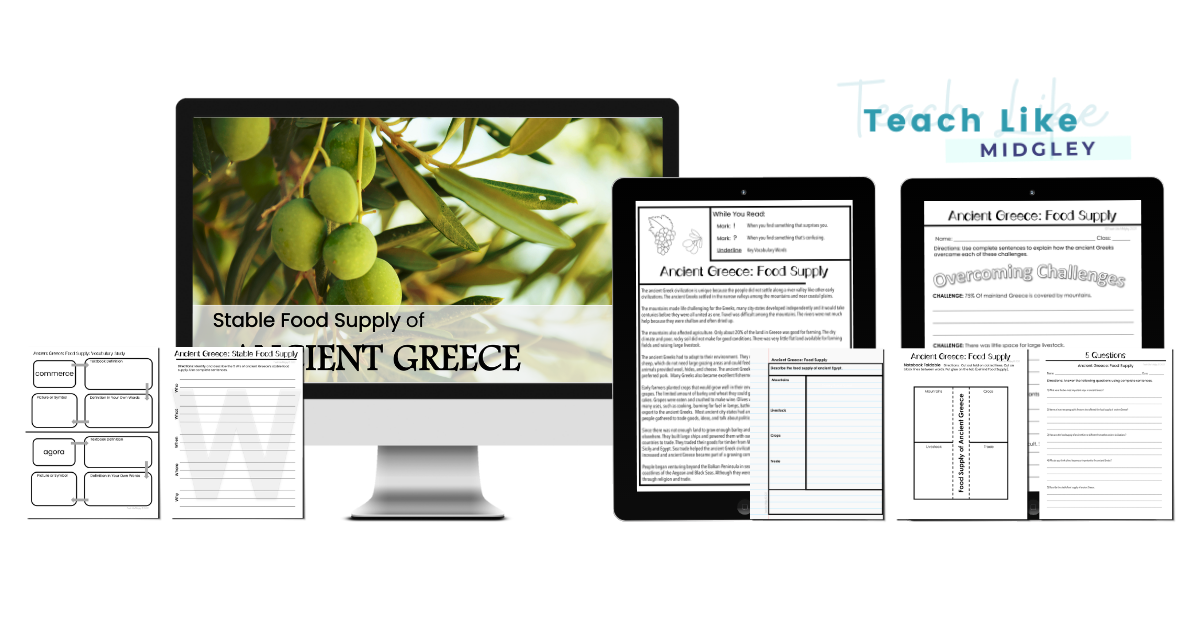How to Teach about Agriculture and Food Supply of Ancient Civilizations to Sixth Graders
Agriculture and food supply is the foundation of any civilization.
It’s impossible to have a permanent settlement, let alone a structured, organized civilization without a food supply.
One of the biggest concepts of our Prehistory units is to teach about the agricultural revolution and how farming lead to the first permanent settlements.
And yet, the aspect of a stable food supply is often overlooked when planning out lessons for the ancient civilizations.
It’s impossible to have a permanent settlement, let alone a structured, organized civilization without a food supply.
One of the biggest concepts of our Prehistory units is to teach about the agricultural revolution and how farming lead to the first permanent settlements.
And yet, the aspect of a stable food supply is often overlooked when planning out lessons for the ancient civilizations.
The ability to farm in any location is dependent on the geography and climate.
Which means when you begin your units with teaching the location of a civilization, it’s natural to move next to how the people were able to farm and establish a stable food supply for the people.
Keep reading this post to discover how you should incorporate this important aspect into your ancient civilization lesson planning for your 6th graders.
Geography of the Region
Ideally, you’ve already covered the geography of the region where the ancient civilization is located. If you’re unsure how to cover location, go back and check out this blog post: How to Teach Location of Ancient Civilizations to 6th Graders.
Core Content
Up next is providing students with core content about farming in the ancient civilization you are about to study. This could come in many different forms: textbook, supplemental readings, learning magazines, online resource, etc.
Most curriculums will focus on the four main river valley civilizations: Mesopotamia, Egypt, India and China. Each of which depend on natural weather events for fertilizing the soil.
Others have unique aspects to their ability to produce food. In Greece, the land is mountainous and rely mostly on crops with shallow roots and the sea to travel for trade. While the Aztecs developed the chinampas which were floating islands of crops and did not rely on weather for irrigation needs.
If you’ve been around here for a while, then you know that when I started teaching sixth grade, I had little to no resources available to me. This experience has been my motivation and driving force behind writing this blog and creating ready-to-roll resources for teachers like you. Each of my Ancient Civilization Lesson Sets comes with a reading passage and a PowerPoint presentation to help you provide core content to your students.
You will also want to make sure you identify key vocabulary terms that students should know to help them further their understanding.
Student Processing Activities
After students have been presented with the core content, next they need the opportunity to process and work with the new information. Writing summaries, completing diagrams or charts, manipulating material in different activities or a worksheet that reinforces key concepts are all excellent choices.
Answering questions using a map of the region, complete with questions that encourage students to make inferences about the impact of geography on the people, is always a good choice.
Another great way to have students work with new content is to have them complete an activity in their interactive notebook with a foldable activity or exercise.
Each of my Ancient Civilization Lesson Sets comes with an worksheet and an activity. While the worksheets are intended to reinforce key concepts, the activities are designed to help your students take the material one step further in their level of thinking.
Answering questions using a map of the region, complete with questions that encourage students to make inferences about the impact of geography on the people, is always a good choice.
Another great way to have students work with new content is to have them complete an activity in their interactive notebook with a foldable activity or exercise.
Each of my Ancient Civilization Lesson Sets comes with an worksheet and an activity. While the worksheets are intended to reinforce key concepts, the activities are designed to help your students take the material one step further in their level of thinking.
Reinforce Key Concepts
The final step to teaching the location of ancient civilizations is to CONSTANTLY revisit and reinforce key concepts.
Every day, every lesson starts the same way, with a brief review of what we’ve already studied. Sometimes this looks like rapid fire questioning while I collect homework. Other days it’s a brief summary.
But it also includes going back and asking students to recall information during new lessons. Especially when we learn about stable food supply, we are talking about what we already know in terms of location and geography.
You may find your students are struggling to remember certain things, this is a flag for you, that they need more practice with the content. Maybe some extra vocabulary work may benefit.
As you progress in your lessons, you also want to help your students take their thinking to the next level and utilize advanced questioning. For each Lesson Set, I developed a set of 5 Questions that follow the lines of Bloom’s Taxonomy Questioning Techniques.
Every day, every lesson starts the same way, with a brief review of what we’ve already studied. Sometimes this looks like rapid fire questioning while I collect homework. Other days it’s a brief summary.
But it also includes going back and asking students to recall information during new lessons. Especially when we learn about stable food supply, we are talking about what we already know in terms of location and geography.
You may find your students are struggling to remember certain things, this is a flag for you, that they need more practice with the content. Maybe some extra vocabulary work may benefit.
As you progress in your lessons, you also want to help your students take their thinking to the next level and utilize advanced questioning. For each Lesson Set, I developed a set of 5 Questions that follow the lines of Bloom’s Taxonomy Questioning Techniques.
Ready to Roll Materials
Now you know exactly how I teach about the agriculture and stable food supply of ancient civilization to my sixth graders and you are ready to do the same!
But if you are struggling to find the materials you need – well, you know I’ve got you covered! No matter which unit you are about to teach, check out my TpT Store for all the Lesson Sets designed to help you teach Food Supply!
You may also be interested in my Continent Maps that I start each unit with and the Map Test Sets to get your students learning those geographic features.
But if you are struggling to find the materials you need – well, you know I’ve got you covered! No matter which unit you are about to teach, check out my TpT Store for all the Lesson Sets designed to help you teach Food Supply!
You may also be interested in my Continent Maps that I start each unit with and the Map Test Sets to get your students learning those geographic features.
You May Also Like...

Welcome! I'm Hillary Midgley, a veteran 6th grade teacher.
I create educational materials and develop curriculum for other teachers. I specialize in teaching students how to learn through my Study Skills Curriculum. I have established fundamental classroom systems and structures for teachers to help them streamline their classroom. And my passion is teaching ancient history through engaging activities with foundations in academic skills. Here you will find resources on all of these topics and more. Learn more about me here.
|













